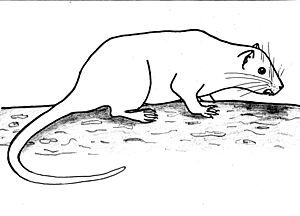San Felipe hutia facts for kids
Quick facts for kids San Felipe hutia |
|
|---|---|
 |
|
| Conservation status | |
| Scientific classification | |
| Genus: |
Mesocapromys
|
| Species: |
sanfelipensis
|
| Synonyms | |
|
Capromys sanfelipensis |
|
The San Felipe hutia (Mesocapromys sanfelipensis), also called the little earth hutia, is a small, rat-like mammal. It is very rare and might even be extinct. This animal was first discovered in 1970. It lives on a tiny island called Cayo de Juan Garcia, which is off the coast of Cuba.
Not much is known about the San Felipe hutia. We know it lives in wet, swampy areas and in coastal forests where mangrove trees grow. It belongs to a group of animals called hutias. Hutias are sturdy rodents that live in the Caribbean islands. Most of them are in danger of disappearing forever or have already become extinct.
Contents
Where the San Felipe Hutia Lives
The San Felipe hutia makes its home on Cayo de Juan Garcia. It might also live on other nearby islands. These islands are part of a group called Cayos de San Felipe. They are located to the west of a larger island called Isla de la Juventud.
What the San Felipe Hutia Looks Like
The San Felipe hutia is a small rodent. Its body is about 8 to 9 inches (20 to 23 cm) long. It has grayish-brown fur and a short tail. Its ears are small, and its body is quite thick.
This animal is nocturnal, which means it is active at night. It usually searches for food when it's dark. Scientists believe it lives in burrows (holes in the ground) or in cracks in rocks near water. It also lives among the roots of mangrove trees in coastal forests.
What the San Felipe Hutia Eats
The San Felipe hutia likely eats different kinds of plants. It also probably eats small invertebrates, which are tiny creatures without backbones. It finds all its food in its coastal home.
Why the San Felipe Hutia is in Danger
The San Felipe hutia faces many threats that put it in danger.
- Introduced Predators: Animals that are not native to the island, like cats or rats, can hunt the hutia.
- Habitat Loss: The places where the hutia lives are being damaged or disappearing.
- Hunting: Sometimes, people hunt these animals.
- New Plants: Plants that are not native to the island can grow quickly and take over the hutia's food sources.
- Rising Sea Levels: The ocean levels are slowly rising. This can shrink the hutia's coastal habitat, leaving it with less space to live.
Protecting the San Felipe Hutia
People are working to protect the San Felipe hutia. These efforts include keeping its coastal home safe. They are also trying to control the number of introduced predators on the island. The goal is to help this rare animal survive.
See also
In Spanish: Jutía de la Tierra para niños


